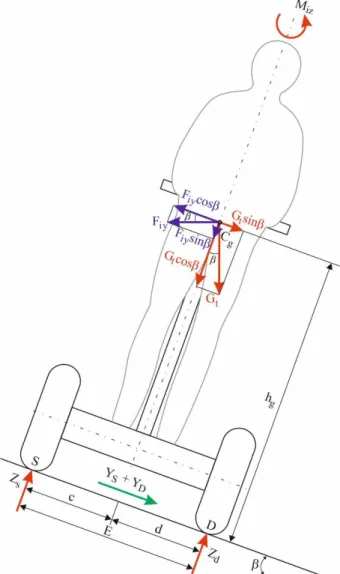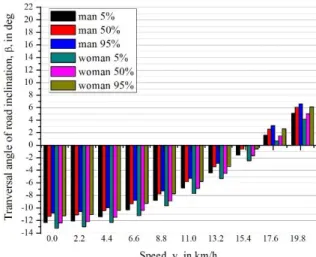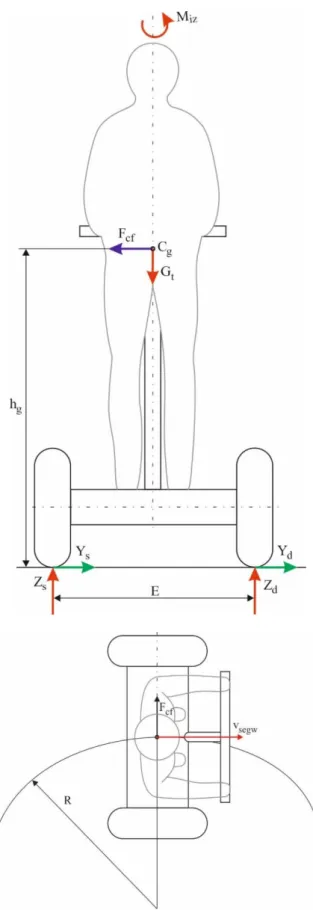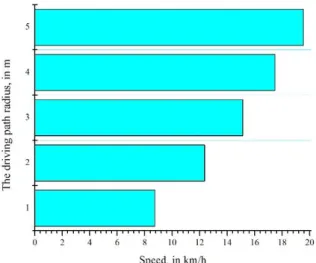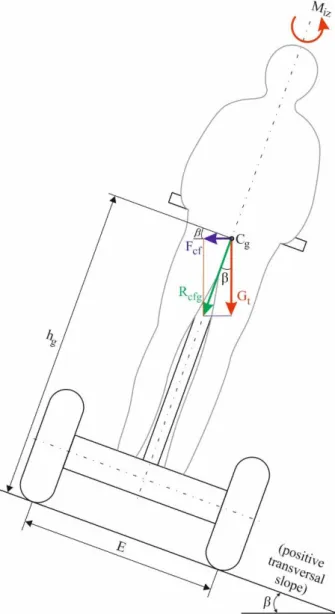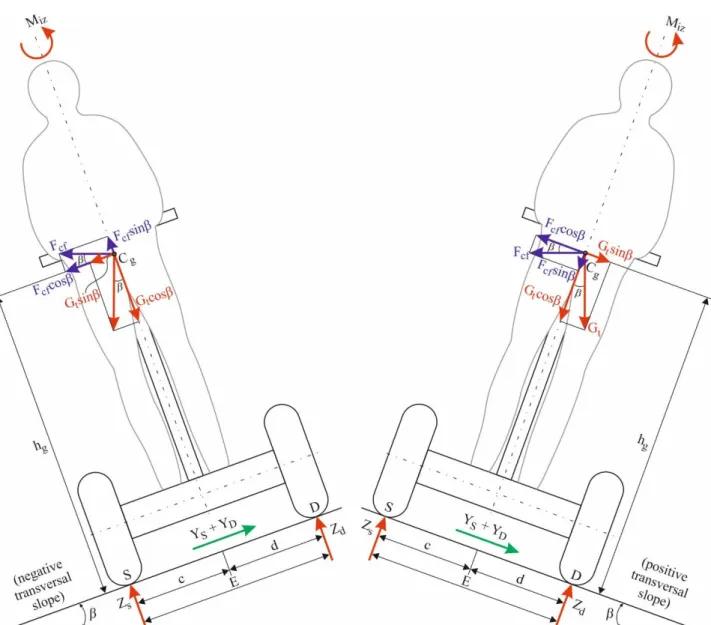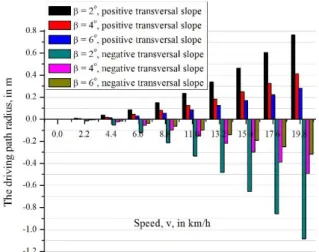TECHNICAL UNIVERSITY OF CLUJ-NAPOCA
ACTA TECHNICA NAPOCENSIS
Series: Applied Mathematics, Mechanics, and Engineering Vol. 60, Issue II, June, 2017
EVALUATION OF THE TRANSVERSAL STABILITY PARAMETERS FOR
THE VEHICLES WITH TWO WHEELS LOCATE IN PARALLEL,
SEGWAY TYPE
Adrian TODORUŢ, Nicolae CORDOŞ, Alexandru MARIAN, Monica BĂLCĂU
Abstract: The paper captures a theoretical study, by numerical modeling concerning the evaluation of the transversal stability parameters for the Segway type vehicles. To the development of the numerical models used were taken into account: the operating mode of the vehicle with two wheels located coaxial; the influence of the pressure in the tire on the dynamic radius of the vehicle and the speed; the forces that acts on the cornering; the influence of the electric engine rotation speed on speed of the vehicle type Segway; the influence of the center of gravity height of the users and their weight on the speed and on the transversal stability of the vehicle; the influence of the angle of transversal inclination of the road on the speed and on the stability of the vehicle. In the study shall be taken into account in matters relating to the different transversal inclinations the of the road, different rays of the trajectory, the different speeds, the main parameters of the Segway type vehicle taken into study and different users (man/woman - 5; 50; 95%). The obtained results are in graphical form and shows: the forces which are obtained between the tire of vehicle and the driving path; the parameters of the transversal stability for the vehicle - in the case of vehicle rollove, through the effect of the transversal grip; in the case of an transversal profile with single slope; in the case of the transversal profile with two flat slope.
Key words: Segway, user, transversal stability, numerical modeling
1. INTRODUCTION
With increasing of the congestion and the pollution in the big cities of the world has been occurred the need for a smaller sizes transport means, more economically and which does not pollute. The transport vehicles, in the configuration with two, three or even four wheels have made the appearance on the market with the aim to meet such needs. The transport vehicles with two wheels located in parallel is also called inverted pendulum, and such an example can be considered the Segway PT [4].
Segway can be used in different environments and its surroundings is often used as vehicles for the craft which do not pollute. The slow movement speed, combined with the electrical propulsion system, makes the Segway the ideal candidate for the transport of persons in different situations - place for recreation,
inside the buildings, sports buildings, etc. Although that the price of their purchase is still high enough, the flexibility and reduced gauge are the main factors which make the Segway an ideal vehicle for the urban transportation. Segway type vehicles are ideal for the carriage of persons in narrow spaces. Because these are two-wheel in parallel, including the platform, and the accelerate, braking or their guidance shall be carried out by means of a handlebar, maintaining the user stability constitute most of the times a real challenge. For this reason it is necessary to an assessment the conditions of stability of these types of vehicles with the aim of the evaluation of their behavior in the operation.
Although it is a vehicle which does not pollute, the system also has some disadvantages such as:
has a high price;
has a legal situation that is still not defined in most countries regarding: the right to circulate on the sidewalk or on the carriageway of the streets, the minimum age of use, the need to bear the protection equipment, the requirement to have the brakes or not and the obligation to hold light signals or warning.
For these reasons, the Segway type vehicle is successful only in particular areas such as: the police units and extended military bases, inside of the airports, staff of out of general stores or in the undertakings and schools with a large surface area of the campsite [3].
With all that at the global level, the Segway type vehicles are marketed in a very wide range [18], still does not exist a uniform legislation [17] regarding the use and prescribes of these vehicles in a specific category of vehicles. However, in Romania, the General Direction of Local Police and Control of the Bucharest Municipality have in endowment Segway type vehicle designed for the agents from the public order for patrol on the streets in the Old Center of Bucharest [15]. In some cities in Romania [16], the Segway type vehicle can be used to make the tour of the main turist sights, users being accompanied by interpreter authorised.
Studies on such vehicles are addressed in [4, 5, 8, 10, 14], where through the using of the dynamic and numerical models, namely by experiment and simulation is obtained remarkable results relating to their dynamics, respectively to their control and maintenance during their movement. The results in [4] provide valuable informations about the dynamic respond of two weeled human transporters. The pitch angle affected the stability when traction was lost from one or both wheels and play a role in how the vehicle climbed an inclined surface. In [10] a model for the two-wheeled robot including wheel slip effects is derived and a wheel slip dependent friction model is used to simulate two low-traction surfaces.
The different situations of using the vehicle taken in the study are surprised by physico-mathematical model. For the evaluation of the
transversal stability parameters of Segway type vehicles it have been developed numeric computing models in which shall take into account the physical phenomena which occur on the movement of these in various conditions of use and which allows the user to obtain the results pursued, with graphics interpretations.
2.NUMERICAL EVALUATION METHOD
2.1. Notations used in the numerical computation model
In numerical models is used a number of variables, as follows:
i - variable (i = 1...imax, where imax = 10) which captures the values of the quantities (M) considered (the inflation pressure of the wheels, engine rotation speed, the running speed of the vehicle, etc.) between a minimum value (Mmin) and the maximum value (Mmax) by defining such a relationship generally valid for the model of the calculation in the form:
1 i M M 1 i M M max min max min i ;j - specifies the center of gravity height of (
j
gu
h ) and the occupant mass ( j
u
m ) [1, 2,
7, 9, 12, 13],
▪ j = 1 - man user, 5%,
(hgu1= 0.993 m; m = 66.21 kg); u1
▪ j = 2 - man user, 50%,
(hgu2 = 1.102 m; mu2= 80.50 kg); ▪ j = 3 - man user, 95%,
(hgu3 = 1.168 m; m = 96.41 kg); u3 ▪ j = 4 - woman user, 5%,
( 4
gu
h = 0.907 m; 4
u
m = 49.44 kg); ▪ j = 5 - woman user, 50%,
( 5
gu
h = 0.985 m; 5
u
m = 59.85 kg); ▪ j = 6 - woman user, 95%,
( 6
gu
h = 1.107 m; 6
u
m = 72.43 kg);
• man/woman 5% - anthropometric dimensions are smaller than at 95% of the adult population male/female;
• man/woman 95% - anthropometric dimensions are higher that in 95% of the adult population male/female;
k - specifies the transversal inclination of the road (k = 14), (k = 0; 2; 4; 6). For example, in the numerical calculation model will be used in the study a Segway type vehicle, about which are known the following: vehicle mass, msegw = 22.4 kg; the total mass of the system,
j j segw u
t m m
M ; the length of the
vehicle, Lsegw = 0.587 m; the width of the vehicle, lsegw = 0.613 m; the height of the vehicle, hsegw = 1.28 m; the height of the platform, hp = 0.153 m; the height from the ground to the platform, hsol = 0.07 m; length of platform, Lp = 0.400 m; width of platform, lp = 0.303 m; the height of the center of gravity of the system composed of the user and the vehicle, hg hgu hsol hp
j
j ; mass of the handlebar, mghid = 0.989 kg; mass of one of the wheels, mR = 4.5 kg; mass of the platform,
ghid R
segw
platf m 2 m m
m ; the width of the wheel, lR = 0.083 m; the ray of the wheel, rR = 0.256 m; the maximum power developed by an engine, PMmot = 0.370 kW; the maximum power developed by the two motors, Pmot = 0.74 kW; the maximum speed of the engine, nmax = 5310 rpm; minimum speed of the engine, nmin = 0 rpm; transmission ratio in the gear, it = 24; the efficiency of the transmission in the case of the drive spur-gear, t = 0.98.
2.2 The evaluation of the stability
parameters to rollover of the segway type vehicle
To determine the transversal stability criteria are considered the Segway type vehicle in cornering on a road with transversal inclination β. The transversal rollover of the vehicle occurs in relation to point S (Fig. 1).
Considering that the vehicle speed v and the cornering radius R are constant, on the basis on the equation of moments from the point of rollover S (see Fig. 1), while taking into account the expression Fiy, inertia force,
F
iy
G
t
v
2(
g
R
)
, by the condition of maintaining the transversal stability at rollover(reaction force ZD = 0), it’s obtain [11] the limit angle of transversal inclination of the road βr, to which the stability of the vehicle at rollover it is at the limit, rollover of the vehicle at this angle being possible at any time:
j j j , i g 2 i g 2 i r h 2 E R g v 1 h 2 E R g v
arctg , (1)
where: v is the speed of the vehicle, in m/s; R - the cornering radius in m; E - gauge of vehicle, in m; g - acceleration due to the gravity in m/s2; hg - the height of the center of gravity of the system composed of the user and the vehicle, in m; j - corresponds to the type of the user of the vehicle.
Fig. 1. The forces and the moments that acting on the vehicle in cornering on the road with transversal
In Figure 2 is captured the variation of the angle limit of transversal inclination of the road depending on the height of the center of gravity of the user, respectively of the running speed of the vehicle, for a driving path with the cornering radius of 5 m. It can therefore be established that the limit angle of the transversal inclination increases with increasing the speed of the vehicle. The minimum value of the angle is located around the -13°, reached in the case when the user is woman 5%. The maximum value of the inclination angle of the road is 21°, in the case when the user is man 95%, at the maximum speed of 5.54 m/s (approximately 20 km/h).
Fig. 2. The variation of the tranversal angle of road inclination according to the speed of the vehicle, for a cornering radius of 5 m, in the case of different users.
In Figure 3 is represented the variation of the limit angle of transversal inclination of the road depending on the height of the center of gravity of the user, respectively of the speed of vehicle, for a driving path with cornering radius of 10 m. Thus, it can be noticed that with the doubling of the cornering radius of the track from 5 m to 10 m, significantly decreases the maximum value of the limit angle of transversal inclination of the road. This is achieved in the case of the same type of the user. The minimum values of the angle of inclination is maintained, when the user is 5%.
The speed limit (vcr) of the two-wheeled vehicle movement in cornering on a road with transversal inclination, which does not happen, but may begin the rollover, is given by the relation [11]:
k g
k g
cr
tg h 2
E 1
tg h 2
E R g
v
j j j
, k
, in m/s, (2)
in which k corresponds to the number of variation of the inclination angle βk.
Fig. 3. The variation of the tranversal angle of road inclination according to the speed of the vehicle, for a cornering radius of 10 m, in the case of different users.
In Figure 4 it can be observed the variation of the speed limit of the vehicle depending on the different tranversal angle of road inclination, respectively of the height of the center of gravity of the user on a driving path with a cornering radius of 5 m. Thus, the critical maximum speed is reached around the value of 4.2 m/s, in the case of a woman user 5% and at an tranversal angle of road inclination of 6°, for driving path with a cornering radius of 5 m.
In Figure 5 is captured the variation of the speed limit of the vehicle depending on different tranversal angles of road inclination, respectively on the height of the center of gravity of the user on a driving path with a cornering radius of 10 m. Thus, it is found that, once with the double of the cornering radius, it changes the critical speed of the vehicle, the maximum speed of the vehicle is being reached in the case of the 4 types of users (user is woman 5%, 50%, 95%, user is man 5%) for an transversal inclination angle of the road to 6°.
Fig. 4. The variation of the critical speed of the vehicle depending on the tranversal angle of road inclination, for
a cornering radius of 5 m, in the case of different users.
Fig. 5. The variation of the critical speed of the vehicle depending on the tranversal angle of road inclination, for
a cornering radius of 10 m, in the case of different users.
2.3. The evaluation of the transversal stability parameters of the Segway type vehicle through the effect of the transversal grip
On a Segway type vehicle, what passes through a curving path of the radius R, on a level road, acts [6] centrifugal force Fcf, transversal grip force (lateral) (YS+YD), normal forces reactions of the road on the drive wheels (ZS+ZD) and the weight of the system (Gt) (Fig. 6).
To prevent the lateral slip of the vehicle it is necessary to fulfill the condition [6]:
D S
cf Y Y
F . (3)
At the limit, the radius of the route traveled by the vehicle is determined by the relation [6]:
g v R
y 2 i
ti , in m, (4)
in which: φy represents the coefficient of transversal grip (φy = 0.6), and g is the acceleration gravitational.
Figure 7 captures the variation of the radius of the path, depending on the speed. Thus, it is found that with increasing the speed of movement of the vehicle, increases the radius of the driving path traveled by the vehicle.
Fig. 7. The variation of the radius of the driving path crossed by vehicle depending on speed.
Fig. 8. The speed variation of the vehicle in accordance with the driving path radius.
Therefore, for a cornering radius of approximately 5 m, the speed of the vehicle approach to the maximum value of about 20 km/h. The vehicle speed can be determined with the relation [6]:
k y
segw g R
v , in m/s, (5)
As shown in Figure 8 is captured the speed variation of the vehicle in accordance with the radius of the path. And in this case, it is noted that the two parameters are directly proportional.
2.4. The evaluation of the transversal stability parameters of the Segway type vehicle in the case of the transversal profile with single slope
Theoretically, the single transversal slope of the road which would complete annihilate the effect of centrifugal force without to consider the contribution of the friction (grip) between the wheels and the driving path (theoretical superelevation), it would be [6] that for which Rcfg resultant of the two forces Fcf and Gt would operate normally on the track surface (Fig. 9). Therefore, the parallel component of the road, which produces the grip, should be zero.
Basically, the combating of the skid is possible only because it leads to excessive values of the cross-inclination [6].
In the case of vehicles rolling in the curve with the lower speeds, the resultant Rcfg is no longer the perpendicular to the surface of the driving path, being guided towards interior. Therefore, the trend of rollover appears toward the inside of the curve, and this is the reason for which the superelevation of the driving path is limited.
For the purpose of calculating the superelevation the road shall apply to the relation:
k
tg 100 [%] p
k
. (6)
The radius of the travelled path by the vehicle shall be determined [6] according to the relation between:
100 [%] p g
v R
k k
, i
2 i
v
, in m. (7)
The variation in the cornering radius depending on the different travel speeds of the Segway type vehicle, at different transversal inclinations of the road β, is captured in Figure 10. Thus, it is found that the cornering radius significantly increases with increasing the speed of the vehicle, but also with the decrease of the transverse tilt angle of the road.
For the purpose of calculating the vehicle speed can be determined [6] the relation:
100 [%] p R g
v s k
k , s
v segw
, in m/s. (8)
In Figure 11 is captured the speed variation of the Segway type vehicle according to the value of the radius of the path, from which it may be established that the vehicle speed with two wheels increases with the increasing of the driving path radius, but also with the increasing of the angle value of the transversal inclination of the road. For the angle value of the transversal inclination by 2° and for a radius of the driving path of 5 m, the speed of the Segway type vehicle reaches the minimum values. At the opposite pole, the maximum speed of the vehicle is obtained in the case of the maximum transversal inclination angle, that is for the maximum operating range of the path.
Fig. 9. Ensuring the vehicle stability in the curve by superelevation.
Fig. 10. The variation of the cornering radius in relation to the vehicle speed at different transversal inclinations
of the road.
Fig. 11. The speed variation of the Segway type vehicle, in accordance with the driving path radius at different
transversal inclinations of the road.
2.5. The evaluation of the transversal stability parameters of the Segway type vehicle in the case of the transversal profile with two flat slope
In this case, the movement of the vehicles on the outer lane is performed [6] on the negative transversal slope, the tilt of the road favoring the sliding (Fig. 12).
Fig. 12. Ensuring the stability of the vehicle in cornering, in the case of the transversal profile with two flat slope (circulation on the negative transversal slope too).
In the case of driving the vehicle on a road with positive, respectively negative transversal slope, from the condition of stability [6] at its movement in a curve, YS + YD ≤ φy·(ZS + ZD) will result (see Fig. 12):
Fcf ·cosβ – Gt·sinβ ≤ φy·(Gt·cosβ + Fcf ·sinβ), (9)
in the case of positive transversal slope;
Fcf ·cosβ + Gt·sinβ ≤ φy·(Gt·cosβ - Fcf ·sinβ), (10)
in the case of negative transversal slope.
For the purpose of combating the skidding in the case of positive or negative transversal slope it is necessary that the relevant conditions are fulfilled [6]:
) p ( g
v R
y 2 i k
, i
, in m, (11)
) p ( R g
vi,k k y , in m/s. (12)
In relations (11), (12), sign (+) corresponds to the positive transversal slope and the (-) negative transversal slope.
positive transversal slope, and in the case of negative transversal slope, respectively for the value of transverse angle inclination of 6°, cornering radius values are the most reduced (in both cases of transversal slope).
Fig. 13.The variation of the cornering radius depending on the speed of the vehicle at different transversal
inclinations of the road.
2.6. The evaluation of forces between the vehicle tires and the driving path
The forces that acts on the wheels are limited by the grip between the tire and the driving path. The higher is the value of the longitudinal force, the lower is the maximum transversal force.
For the calculation of the longitudinal and transversal forces that are transmitted between the tire and the driving path it can be used the diagram in Figure 14 [12], in which v is the speed; F - the road reaction force on the wheel; Fx, Fy - projections of the reaction in the longitudinal direction, respectively transversal; Z - vertical reaction force of the road at the driving wheels; α - the angular speed positions.
Fig. 14 The scheme of forces between tire and the driving path (grip ellipsis).
The maximum value of the longitudinal reaction of the ground to the vehicle can be calculated according to the relation [12]:
j x
x Z
F j
max , (13)
in which: φx is the coefficient of lateral grip of which depends on the type of the road; j - corresponds to the type of the vehicle user.
The maximum value of the transversal reaction can be calculated according to the relation [12]:
j y
y Z
F j
max , (14)
In which φy is the coefficient of lateral grip (φy0.8·φx).
The ellipse grip changes its parameters according to the nature and condition of the road, the travel speed and the vehicle's load condition. In the event that one of the reactions has the maximum value possible, the other reaction forces should be zero. A lower value than the maximum possible, of a reaction, allows an increase of the other reaction, so that their resultant do not come out of the grip ellipse.
Fig. 15. The variation of the maximum longitudinal and transversal forces, depending on the vehicle user. MU1 - man user 5%; MU2 - man user 50%; MU3 - man
user 95%; WU1 - woman user 5%; WU2 - woman user 50%; WU3 - woman user 95%.
case of men users is higher than in the case of users is women, the maximum longitudinal reaction is directly proportional to the vertical reaction force of the road on the wheel. It may be observed that the maximum transversal reaction has less value than the longitudinal reaction force. This is due to the side grip coefficient (φy), which is lower than the longitudinal grip coefficient (φx).
3. CONCLUSIONS
The studies undertaken on the assessment of the conditions and stability qualities two-wheeled parallel vehicles allowed the following conclusions:
the need to increase the autonomy of electric vehicles in order to increase their performance and their exploitation is an important step in the development of these types of vehicles;
traffic congestion produced in major cities can be reduced by using Segway type vehicles, given that these vehicles have a low gauge and can be used in narrow spaces;
the change in tire pressure in turn leads to a change in the dynamic radius or to a change on the speed of the Segway type vehicle;
the change of two electric motors rotation speed located inside the platform of the vehicle has a major impact on the speed of the vehicle;
the transverse stability of the vehicle is directly influenced by the user's weight and height of the center of gravity of the vehicle, the radius of curvature of the path traveled by the vehicle and the speed with which it enters in cornering (see Fig. 2, Fig. 3);
in the case of the tansversal stability of the vehicle, it is noted that with the increase of the speed of the vehicle, the transversal slope of the tread is also increasing according to the vehicle user; the two sizes - the angle of inclination and the speed of movement - are in a proportionality relationship; if the value
of the tilt angle increases, the critical speed of the vehicle in cornering will also increase;
in the case of the transversal stability of the vehicle, by the effect of the transversal grip, it is found that the vehicle radius of cornering is directly influenced by its speed; the same influence takes place also in the context of the transversal stability, in the case of the single-slope transversal profile, respectively with two flat slopes, with the mention that in these cases also the angle of the road transversal slope is taken into account; the radius of rotation increases as the speed of the vehicle increases, but also with the lowering of the transverse tilt angle of the rolling path;
in order to maintain its transversal stability, the speed of the Segway type vehicle must be adjusted according to: the transverse tilt of the road, the weight of the user, and the cornering radius of the road;
the maximum longitudinal and transversal reaction of the rolling path vary with the weight of the vehicle and with the user (see Fig. 15); the maximum transversal and longitudinal forces between the wheels of the vehicle and the rolling path are limited by the grip between the tire and the road, and the higher value of the longitudinal reaction is, the lower decrease the maximum transversal reaction.
As possible further prospects of these studies is proposed to extend theoretical research to determine:
the influence of the vibrations produced by the rolling path on the acceleration and on the speed of the Segway type vehicle; the speed of the Segway type vehicle
according to the type of occupant, respectively according to the nature and condition of the road;
the influence of the longitudinal inclination angle of the road on the angle of inclination for Segway type vehicle handlebar;
self-propelling parameters for different road categories of hoverboards Segway type vehicles wich are not fitted with the handlebars.
4. REFERENCES
[1]Ahlstrom, V.; Longo, K., Human Factors Design Standard (HF-STD-001), Atlantic City International Airport, NJ: Federal Aviation Administration William J. Hughes Technical Center, 2003
(amended/updated 2009),
http://hf.tc.faa.gov/hfds/download-hfds/ (accessed on 03/04/2017).
[2]Ahlstrom, V., Human Factors Design
Standard (DOT/FAA/HF-STD-001B).
Atlantic City International Airport, NJ: Federal Aviation Administration William J. Hughes Technical Center, 2016, http://hf.tc.faa.gov/publications/2016-12-human-factors-design-standard/full_text. pdf (accessed on 03/04/2017).
[3]Arvidsson, M.; Karlsson, J., Design, construction and verification of a self-balancing vehicle, Chalmers University of Technology, Göteborg, Sweden, 2012, http://publications.lib.chalmers.se/records/f ulltext/163640.pdf, (accessed on 12/02/2016).
[4]Castro, Arnoldo, Modelling and dynamic analysis of a two-wheeled inverted-pendulum. M.S. thesis, Dept Mechanical Engg, Georgia Institute of Technology, Georgia, US, 2012, https://www.course hero.com/file/14391789/castro-arnoldo-201208-mastpdf/, (accessed on 12/02/2017).
[5]Clark, M.A.; Field, G.B.; McMahon, S.G.; Philps, P.S., EDGAR, A Self-Balancing Scooter, Final Report, The University of Adelaine, Australia, October 27, 2005, http://data.mecheng.adelaide.edu.au/roboti cs/projects/2005/Edgar/Edgarfinalreport. pdf, (accessed on 07/04/2016).
[6]Diaconu, Elena; Dicu, M.; Răcănel, Carmen, Căi de comunicaţii rutiere - principii de proiectare, București, Editura Conspress, 2006.
[7]Donald E. Struble. Automotive Accident Reconstruction: Practices and Principles (Ground Vehicle Engineering Series). Editura CRC Press, Taylor & Francis Group, LLC, 2014.
[8]Grasser, F.; D’Arrigo, Colombi, S. and Rufer, A., JOE: A mobile inverted
pendulum, IEEE Trans Industrial
Electronics, 49 (1):107114, http://d1.amobbs.com/bbs_upload782111/f iles_10/ourdev_264005.pdf, (accessed on 27/01/2016).
[9]Huston, L.R., Principles of biomechanics, CRC Press, Taylor & Francis Group, 2009. [10]Jones, Daniel R., and Stol, Karl A.,
Modelling and stability control of
two-wheeled robots in low-traction
environments. Australasian Conference on Robotics and Automation, Brisbane, Australia, 2010.
[11]Todoruț, A., Bazele dinamicii autovehiculelor. Algoritmi de calcul. Teste.
Aplicații, Editura Sincron, Cluj-Napoca,
România, 2005.
[12]Todoruț, A.; Barabas, I.; Burnete, N.,
Siguranța autovehiculelor și securitatea în
transporturi rutiere, Editura U.T.PRESS, Cluj-Napoca, România, 2012.
[13]Todoruţ, A.; Cordoş, N.; Barabás, I.; Bălcău, Monica, The evaluation of kinematic measures which characterize the vehicle-pedestrian accidents. Cluj-Napoca, Buletinul Ştiinţific al UTC-N, Acta Technica Napocensis, Series: Applied Mathematics, Mechanics, and Engineering, Vol. 58, Issue I, March, 2015, pg. 31-40, Editura U.T.PRESS, ISSN 1221-5872, http://www.atna-mam.utcluj.ro/index.php/ Acta/article/view/513.
[14]Younis, W.; Abdelati, M., Design and
Implementation of an Experimental
net/profile/Mohamed_Abdelati/publication /253916862_Design_and_Implementation_ of_an_Experimental_Segway_Model/links/ 54db322f0cf233119bc56ea9.pdf, (accessed on 31/01/2017).
[15]*** Poliția Locală și-a cumpărat 10
Segway-uri, mașină de teren și motociclete
cu peste 200.000 €, http://www.b365.ro/ achizi-ii-de-lux-la-poli-ia-capitalei-peste- 140-000-euro-pentru-o-ma-ina-i-doua-motociclete_195350.html#n, (accessed on 15/02/2017).
[16]*** Segway,
http://www.authentic-travel.ro/tururi-interne/segway.html, (accessed on 15/02/2017).
[17]*** Segway PT explained,
http://everything.explained.today/Segway_ PT/, (accessed on 14/03/2017).
[18]*** Segways for Sale Alternative Personal
Transporter Electric Scooters,
https://www.pinterest.com/segwaystyle/seg
ways-for-sale-alternative-personal-transporter-/, (accessed on 14/03/2017).
EVALUAREA PARAMETRILOR STABILITĂŢII TRANSVERSALE A VEHICULELOR CU DOUĂ ROŢI AMPLASATE ÎN PARALEL, DE TIP SEGWAY
Rezumat: Lucrarea surprinde un studiu teoretic, prin modelare numerică, privind evaluarea parametrilor stabilităţii transversale a vehiculelor de tip Segway. La dezvoltarea modelelor numerice utilizate s-a ţinut seama de: modul de funcționare al vehiculului cu două roți amplasate coaxial, de tip Segway; influența presiunii din pneu asupra razei dinamice a vehiculului și a vitezei de deplasare; forțele care acționează asupra vehiculului aflat viraj; influența turației motoarelor electrice asupra vitezei de deplasare a vehiculului de tip Segway; influența înălțimii centrului de greutate al utilizatorilor, cât și a greutății acestora, asupra vitezei de deplasare și a stabilității transversale a vehiculului; influența unghiului de înclinare transversală a drumului asupra vitezei de deplasare și a stabilității vehiculului. În studiu sunt luate în considerare aspecte referitoare la diferite înclinări transversale ale drumului, diferite raze ale traiectoriei, diferite viteze de deplasare, parametrii principali ai vehiculului de tip Segway luat în studiu și diferiți utilizatori (bărbat/femeie - 5; 50; 95%). Rezultatele obținute sunt sub formă grafică și surprind: forțele care iau naştere între pneul vehiculului și calea de rulare; parametrii stabilităţii transversale a vehiculului - la răsturnare; prin efectul aderenței transversale; în cazul profilului transversal cu pantă unică; în cazul profilului transversal cu două versante plane.
Adrian TODORUŢ, PhD. Eng., Associate Professor, Technical University of Cluj-Napoca, Faculty of Mechanical Engineering, Department of Automotive Engineering and Transports, Romania, adrian.todorut@auto.utcluj.ro, Office Phone 0264 401 674.
Nicolae CORDOŞ, PhD. Eng., Lecturer, Technical University of Cluj-Napoca, Faculty of Mechanical Engineering, Department of Automotive Engineering and Transports, Romania, Nicolae.Cordos@auto.utcluj.ro, Office Phone 0264 202 790.
Alexandru MARIAN, Eng., Automotive Engineering - Road Vehicles, & Student of Master - Computer aided design and manufacturing systems, Technical University of Cluj-Napoca, Faculty of Machine Building, Engineering Design and Robotics Department, alex.marianm@gmail.com.
